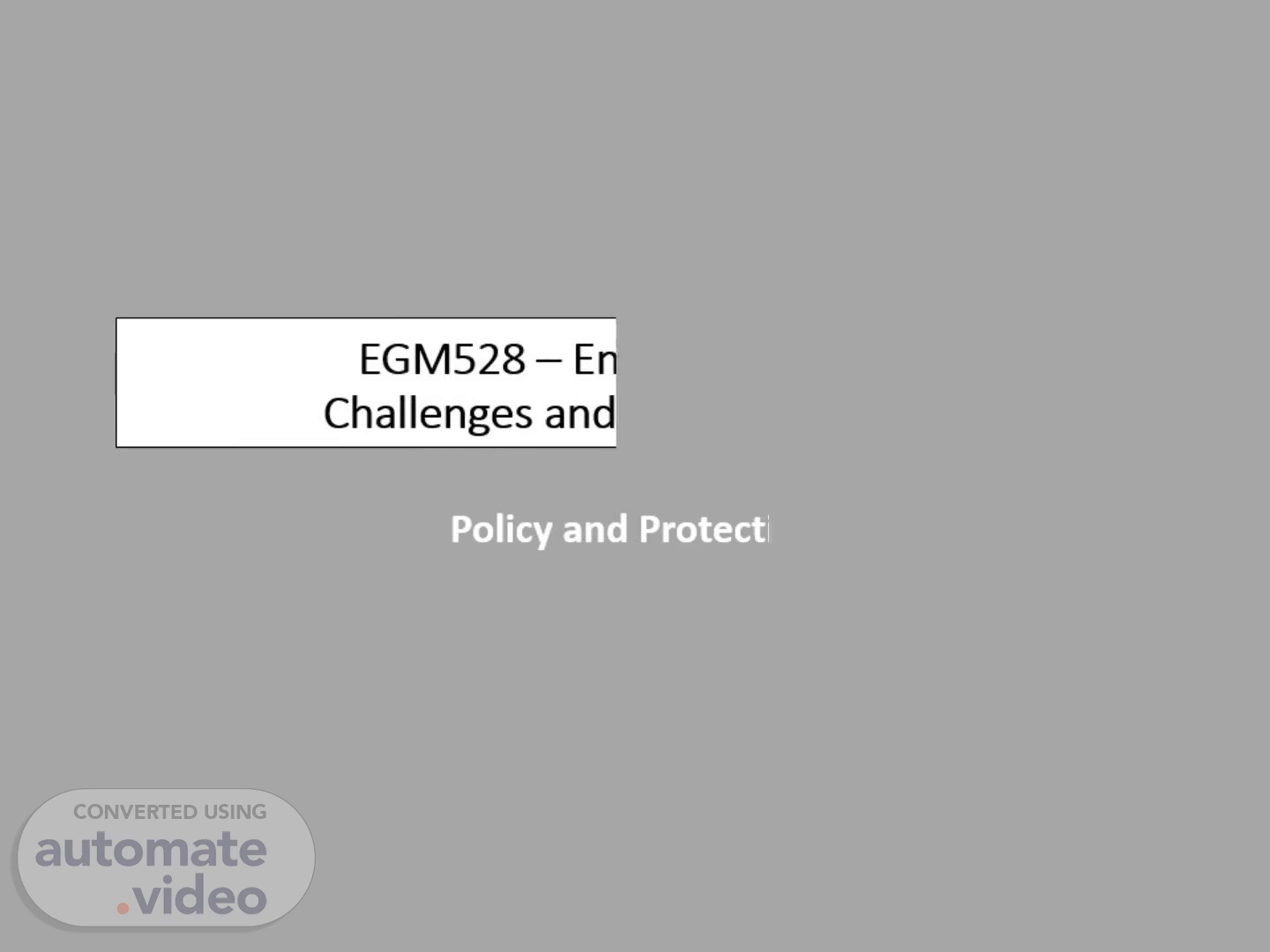
Page 1 (0s)
EGM528 – Environmental Challenges and Management.
Page 2 (7s)
In this lecture we will: Look at the background and establishment of protected areas for nature Review how protection is governed in Northern Ireland and the mechanisms used to facilitate it Review the international and national designations supporting environmental protection Recognise the difficulties and challenges of protection.
Page 3 (22s)
Historically, protecting habitats was about protecting game Public Resources such as watershed protection e.g. Mourne catchment Nature for its own sake.
Page 4 (34s)
Pre-WWI protection of birds; nature reserves for scientific studies. Increasing pressures on nature from urban development, agricultural intensification by the mid-20th century. Nature Conservancy (1949) in Britain (not NI); split into country conservation agencies The Joint Nature Conservancy Council (JNCC) was created (1990) as a public advisory body to these agencies. Northern Ireland - nature conservation sits within DAERA, and since 2006 also comes under the advice of the JNCC..
Page 5 (56s)
Nature Conservation in NI – Statutory Level. Government: NI Environment Agency (within Department of Agriculture, Environment and Rural Affairs (DAERA).
Page 6 (1m 13s)
Each jurisdiction of the UK has statutory advisors These are publicly-funded bodies which advise the Departments on matters relating to nature conservation – e.g. CNCC in Northern Ireland, SEPA in Scotland However these bodies are not independent of government and in 2021 were replaced (NI & England) with the Office for Environmental Protection (OEP) As an independent UK-level body it will ensure regulators are maintaining standards and consistency..
Page 7 (1m 30s)
RSPB. Nature Conservation in NI – Non-Statutory Level.
Page 8 (1m 44s)
Mechanisms / tools for the protection of Nature: Multilateral Environmental Agreements protecting habitats/ species (i.e. international agreements) 2. Protected landscapes e.g. AONBs 3. Protected sites e.g. nature reserves 4. Planning system.
Page 9 (2m 1s)
What is a protected area?. ‘A clearly defined geographical space, recognised, dedicated and managed, through legal or other effective means, to achieve the long-term conservation of nature with associated ecosystem services and cultural values.’ IUCN definition.
Page 10 (2m 15s)
Landscape / Site protective designations: Sites protected by global agreements e.g. World Heritage Sites, Ramsar. Sites protected by the EU ‘Nature Directives’ - SPAs and SACs. Sites protected by NI legislation e.g. ASSIs. Local authority designations- Local Nature Reserves..
Page 11 (2m 34s)
Special Protection Areas (SPAs). EU ‘Birds’ Directive Areas of the most important habitat for rare (Annex 1 list) and migratory birds in the EU..
Page 12 (2m 46s)
Special Areas of Conservation (SACs). EU ‘Habitats’ Directive Areas which have been identified as best representing the range and variety of habitats and species (not birds) listed under Annex I and II of the Directive..
Page 13 (3m 1s)
Ramsar Sites. Promote wetland conservation and wise use of wetlands. Sites are designated under the Convention on Wetlands of International Importance, Iran 1971..
Page 14 (3m 13s)
ASSIs / AONBs. Areas of Special Scientific Interest (ASSIs) - protected areas that represent key wildlife and geological sites. Areas of Outstanding Natural Beauty (AONB) - designated for conservation due to its significant landscape value (natural and cultural)..
Page 15 (3m 29s)
None in Northern Ireland! Long proposed for the Mourne Mountains, it has been met with considerable opposition due to fears of restrictions Established to conserve and enhance landscapes, National Park legislation favours conservation over all other priorities (Sandford Principle, 1974)..
Page 16 (3m 48s)
1. Are they meaningful? 2. Are they effective? 3. Are they managed?.
Page 17 (4m 9s)
Pressures affecting designated sites. Regardless of designation, sites still have to contend with: Natural processes: Geological / Ecological forces Human pressures: Social, Economic and Cultural forces.
Page 18 (4m 21s)
1. Legislation 2. Boundaries 3. Governance. Protected Sites - Issues.
Page 19 (4m 29s)
Protected Sites. Natural world How strictly should the natural world be protected? How do you successfully capture biodiversity within a PA boundary? How do you protect it from threats?.
Page 20 (4m 46s)
Government (or government agencies). A range of parties (shared governance). Owners of the land and the natural resources (e.g. individuals, companies etc). Indigenous peoples and local communities..
Page 21 (5m 1s)
Enhancement of protection is important: Partnership approaches Stakeholders Role of people as stewards of the landscape Consider what defines success and how it will be measured..
Page 22 (5m 12s)
Education/ awareness raising/ training Regulation- enforceable rules (with legal basis), standards, inspection process. Market incentives e.g. certification systems to maintain standards, ‘branding’ of traditional products, niche markets. Financial incentives e.g. agri-environment schemes (operated by gov/ public agencies)..
Page 23 (5m 31s)
Voluntary, 5 years, not a whole farm scheme. Biodiversity Water quality Soil quality Carbon capture and storage and greenhouse gases and ammonia.
Page 24 (5m 42s)
Farmer chooses land parcels to go in and their options from a suite of options. E.g. creation of pollinator margins, hedge laying with 2 protective fences..
Page 25 (6m 5s)
To bring priority habitats and species inside and outside of designated areas under favourable management. Production of a site-specific remedial management plan that specifies EFS options..
Page 26 (6m 18s)
Protected area – questions…. Useful questions for your assessment… For what purpose is the protected area being managed? What is its size? What species/ ecosystem/ landscape is being protected? What is the nature of the management body or governance structure? What resources are available to manage the protected landscape? What are the principal management challenges?.
Page 27 (6m 35s)
Protected area - Tools. Spatial Map Viewers hosted by DAERA.